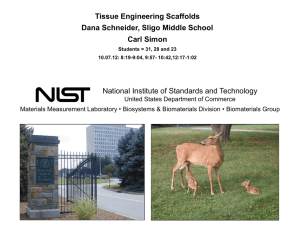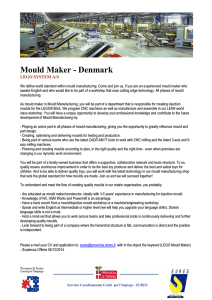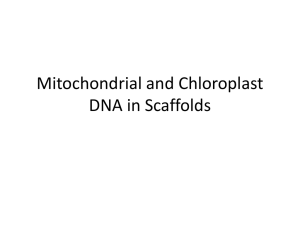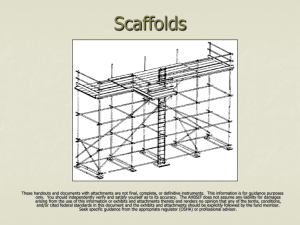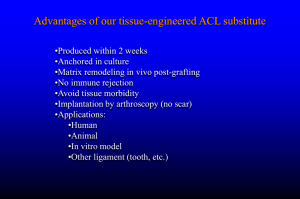Scaffold preparation - University of Cambridge
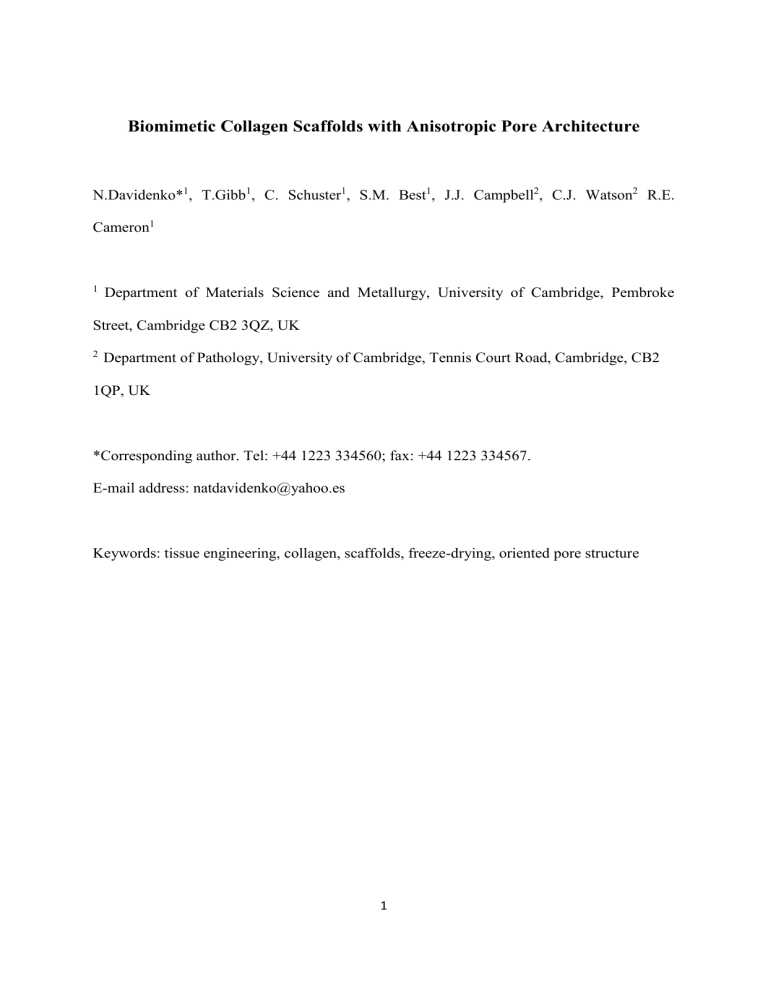
Biomimetic Collagen Scaffolds with Anisotropic Pore Architecture
N.Davidenko* 1 , T.Gibb
1 , C. Schuster 1 , S.M. Best 1 , J.J. Campbell 2 , C.J. Watson 2 R.E.
Cameron
1
1
Department of Materials Science and Metallurgy, University of Cambridge, Pembroke
Street, Cambridge CB2 3QZ, UK
2 Department of Pathology, University of Cambridge, Tennis Court Road, Cambridge, CB2
1QP, UK
*Corresponding author. Tel: +44 1223 334560; fax: +44 1223 334567.
E-mail address: natdavidenko@yahoo.es
Keywords: tissue engineering, collagen, scaffolds, freeze-drying, oriented pore structure
1
Abstract
Sponge-like matrices with a specific 3D structural design resembling the actual extracellular matrix (ECM) of a particular tissue show significant potential for the regeneration and repair of a broad range of damaged anisotropic tissues. The manipulation of the structure of collagen scaffolds using a freeze-drying technique was explored in this work as an intrinsically biocompatible way of tailoring the inner architecture of the scaffold. The research was focused on the influence of temperature gradients, imposed during the phase of crystallisation of collagen suspensions, upon the degree of anisotropy in the microstructures of the scaffolds produced. Moulding technology was employed to achieve differences in heat transfer rates during the freezing processes. For this purpose various moulds with different configurations were developed with a view to producing uni-axial and multidirectional temperature gradients across the sample during this process. SEM analysis of different crosssections (longitudinal and horizontal) of scaffolds revealed that highly aligned matrices with axially directed pore architecture were obtained where single unidirectional temperature gradient was induced. Alteration of freezing conditions by the introduction of multitemperature gradients allowed collagen scaffolds to be produced with complex pore orientations, and anisotropy in pore size and alignment.
2
1.
Introduction
Every tissue and organ has its own specific 3-dimensional (3D) extracellular matrix structure. Cells in a 3D support for tissue engineering (TE) typically align new ECM components according to the inner architecture of the bioscaffold [1-3]. Therefore, spongelike matrices with a specific 3D structural design resembling the actual ECM of a particular tissue would show great potential for the regeneration and repair of a broad range of damaged anisotropic tissues.
Several approaches have been reported to date for the production of scaffolds with anisotropic arrangements, mostly with longitudinal pore alignment. Many of these procedures are based on heating and/or use of harsh chemicals [4-8]. For example, the techniques of injection moulding and solvent evaporation [4], fibre templating [5], porogen leaching [6], microfilament alignment [7], and wire-heating [8] involve the incorporation, and subsequent removal, of additional chemicals, polymeric fibres, or metal wires, from the scaffold architecture to obtain the desired pore orientation. Such methods may be applied effectively for the production of 3D matrices from synthetic polymers but are not to be recommended for proteins, since these would become denatured and their biological properties would be destroyed [9-10]. Hence, despite the success of the above mentioned methods for producing anisotropic scaffolds, the complexity of the processes themselves and the use of additional chemicals demand that novel technologies be developed for forming tissue-specific matrices.
An important technique which overcomes the above obstacles is that of freeze drying. In this case a suspension of the water-soluble polymer is frozen, thereby creating an interpenetrating network of ice crystals [11-14]. These ice crystals are then removed by reducing the chamber pressure to induce sublimation, thus leading to the formation of a porous scaffold .
Studies show that uniform conditions throughout the sample on freezing
3
induce an isotropic pore arrangement in the lyophilised biopolymer [12-15 ]. O´Brien el al.
[12], for example, reported the synthesis of highly uniform collagen-glycosaminoglycan (CG) scaffolds by adjusting mould size and cooling rate. In this work the conventional freezedrying technique was modified to create an even more uniform contact between the pan containing the CG suspension and the freezing shelf. At the same time the rate of cooling of the CG suspension was slowed down in order to produce more homogeneous freezing conditions during the process of formation. These modifications led to increase in homogeneity of the scaffold structure
Recently, improved methods for producing collagen-based scaffolds have been detailed where pore structure homogeneity and mean pore size have been altered and controlled so as to produce scaffolds with the required inner architecture . It was reported that the introduction of a unidirectional temperature gradient in the suspension during the freezing phase induced linear anisotropy in the scaffold morphology in the direction of this gradient [16-18] . For example, agarose [17,18] and collagen-based matrices [16] with axially oriented pore structures, produced by freeze-drying, have recently been described in the literature. It is of note that in these studies scaffolds with different pore diameters and orientations were obtained. These papers used apparently similar temperature regimes, but different mould designs.
A different approach to producing a radial pore size gradient in collagen-based scaffolds was reported by Harley et al. [19]. By use of a spinning technique, whereby the spinning time and/or spinning velocity of the CG suspension were varied, a novel process was developed in this work to create a broad range of tubular 3D matrices with radically aligned pore structures. Matrices with such an anisotropic arrangement were produced to facilitate the study of myofibroblast migration during peripheral nerve regeneration.
4
Collagen, in particular Type I, with its range of useful properties, such as low antigenicity, biocompatibility and appropriate mechanical characteristics, has frequently been employed as the main scaffold material [15, 16, 20-22 ]. Collagen scaffolds may be formed by freeze-drying their aqueous suspensions to which an organic acid is often added to encourage the formation of a dendritic ice crystal network without side branching [15-16]. Following ice sublimation, a pore structure with exactly the same morphology as the ice crystals is produced in the scaffold. This makes it possible to control the properties of the scaffold topography by adjusting the processing conditions.
The manipulation of the structure of collagen sponges would, therefore, be a matter of great interest, since this would provide an intrinsically biocompatible way of tailoring the scaffold to the precise requirements of the tissue to be re-grown. With this in mind, the current work was directed to the study of the influence of temperature gradients, imposed during the phase of crystallisation of collagen suspensions, upon the inner structures of collagen scaffolds prepared by a lyophilisation technique, with the aim of obtaining cellsupports resembling the in vivo 3D organization of the ECM. Moulding technology was employed to achieve differences in heat transfer rates during the freezing processes. For this purpose various moulds with different configurations were developed with a view to producing a range of temperature gradients during the freezing stage and, hence, inducing different degrees of anisotropy in the microstructures of the scaffolds.
2.
Materials and methods
2.1
Scaffold preparation
5
By use of the technique of freeze-drying various collagen scaffold samples with different pore alignments were produced. A 1%-wt suspension of an insoluble, type I microfibrillar collagen derived from bovine Achilles tendon (Sigma-Aldrich Co. Ltd., UK) was prepared in
0.05 M acetic acid solution (Sigma-Aldrich Co. Ltd., UK), and the pH value of the resulting solution was adjusted to below 2.0 with 1M hydrochloric acid (VWR International Ltd., UK).
This suspension was blended at 20,000 rpm using an overhead homogenizer for 30 min at
4
C, and then, after mixing, centrifuged in a bench-top centrifuge at 2500 rpm for 5 min to remove air bubbles formed during the blending. The prepared collagen suspension was divided into five portions each of which was then frozen in a different shaped mould. These moulds, described as follows, were designed in such a way as to create different temperature gradients in the cast sample during the freezing stage.
Mould 1 was made entirely from high thermal conductivity 316L stainless steel
(d=45mm; h=13mm) in a cylindrical format to produce a uniform temperature throughout the collagen suspension during freezing (Fig1, M 1).
Mould 2 was a modified version of Mould 1 where an insulating tubular Perspex insert
(20 mm thick) was located in the cylindrical steel vessel so as to produce a temperature gradient from the base to the top of the freezing sample (Fig 1, M 2).
Mould 3 was designed to produce a greater temperature gradient to that of Mould 2 by altering the ratio between the conductive (base) and the insulated (wall) sections of this holder. In this case the steel base was replaced by a highly conductive flat copper base, and cylindrical holes (d=10mm and h=30mm) were machined in the Perspex insert (Fig1, M 3).
Mould 4 was designed with the objective of forming two different temperature gradients: one horizontally (across the sample) and the other vertically (from the base to the surface of the sample). In this case the vessel was cubic, and the base consisted of an inverted copper wedge supported on a Perspex wedge of similar dimensions (Fig1, B ).
6
Mould 5 was similar to Mould 4, but in this case the positions of the copper and Perspex wedges were inverted so that the Perspex wedge (minimum thickness 0.1mm to a maximum
10mm) then separated the collagen suspension from the copper wedge base and was used to produce a more defined temperature gradient across the horizontal plane of the freezing suspension.
A relatively high freezing temperature (-30
C) and a relatively slow rate of cooling (less that 1
C min
-1
) were the freeze-drying conditions chosen to promote the formation of larger sized ice crystals (100 micrometres or above). The frozen suspensions were subsequently sublimed at 0
C for 24 h under vacuum at less than 100 mTorr.
To enhance the structural stability of the collagen scaffolds, their lyophilised samples were cross-linked with a water-soluble carbodiimide (EDC). These scaffolds were immersed in a 95% ethanol solution containing 33mM 1-ethyl-3-(3-dimethylamino propyl)carbodiimide hydrochloride (EDC, Sigma-Aldrich Co. Ltd., UK) and 6mM Nhydroxysuccinimide (NHS, Sigma-Aldrich Co. Ltd., UK) for 4 h at 25
C. Following the crosslinking process the scaffolds were washed thoroughly with distilled water (5 x 5 min) and were subsequently re-frozen and re-lyophilized using the freeze-drying cycle detailed above.
2.2
Temperature gradient
Temperature gradients created during the freezing stage in each mould were measured by inserting thermocouples at different points in the collagen suspension. For Moulds 1, 2 and 3 the thermocouples were placed at the top of the scaffold (close to the collagen suspension/air interface) and at the base of the mould itself where it made contact with the cooling shelf of
7
the freeze dryer (Fig 1A). In the case of Moulds 4 and 5 the base temperatures were measured on both sides of the copper wedge (see Fig 1B) at the base of the mould.
2.3 Pore volume fraction
The pore volume fraction (%) of the scaffold, Vf, was calculated according to the following equation:
Vf = (Vt-Vc/Vt ) x100% = (Vt-(m/d)/Vt) x100% where: Vc, volume occupied by the collagen; Vt, total volume of the scaffold; d, density of anhydrous collagen (assumed to be 1.3 g/mL); and m, mass of scaffold.
2.4 Scaffold morphology
A scanning electron microscopy (SEM) (JEOL 5800) was used to determine the pore structures of the scaffolds. Samples were sputter-coated with a layer of platinum for observation at 10kV at various levels of magnification.
In the case of Moulds 1-3, both longitudinal and transversal horizontal sections from the top and the bottom extremes of the scaffold were examined in order to identify any differences in pore size across the sample resulting from the imposed temperature regime.
In the case of Moulds 4 and 5, eight cross-sections of each sample were examined under the SEM, in order to determine the three dimensional pore structure of the sponges produced.
These sections were selected and cut with considerable care to ensure that their orientation with respect to the body of the sample was known at all times, thereby permitting the pore orientation to be determined precisely.
3.
Results and Discussion
8
3.1 Temperature gradient
The temperatures observed during cooling are shown in Figures 2-3 . The results are described as follows.
Mould 1 : It was found that in this mould no temperature difference existed between the top and bottom of the cast scaffold suspension (Fig 2, A ), meaning that the entire collagen suspension was frozen and lyophilised under homogeneous temperature conditions. This leads to the premise that the resultant scaffold should display an isotropic inner architecture.
Mould 2: This mould, with the same construction as Mould 1, but containing a Perspex insert, produced a longitudinal temperature gradient during the cooling stage from the bottom to the top of the sample (Fig 2, B1 ), which was not homogeneous throughout all the freezing process, but at some point reached ∆~16
C. This gradient profile might possibly result from the fairly extended conducting area on the bottom of this mould, which equilibrates the temperature between the top and the base as time advances.
Mould 3 : In this case, where the size ratio between the conductive (base) and the insulated (wall) sections of this holder was significantly diminished (in comparison to Mould
2), a fairly stable longitudinal temperature gradient (mainly in the range ∆~16-18
C) from the bottom to the top of the sample during all the freezing period (Fig 2, B2 ) was clearly produced. This confirms that the design of this mould is suitable for inducing a fairly constant unidirectional temperature gradient. The presence of a single temperature gradient was expected to produce uniaxial linearly orientated pore alignment in the direction of the temperature gradient. It is of note that both: top and bottom temperatures are equilibrated on the subsequent freeze-drying phase (results not shown) when a vacuum is applied to sublime ice crystals from the frozen collagen suspension.
9
Mould 4: Here an attempt was made to create a temperature gradient horizontally across the sample. However, the bottom temperatures measured on both sides of the copper wedge shown no difference in their values (Fig 3 A), suggesting that a horizontally orientated temperature gradient had not been achieved in this mould. This result can be explained by virtue of the position of the copper wedge on the base of the holder, where despite the differences in wedge thickness on each side of the mould (from 1 to 10 mm), the high conductivity of this material causes the temperature throughout the entire base to rapidly equilibrate, and as a result heat flows only longitudinally from the bottom to the top during the freezing and crystallisation phase, in a way similar to that of Mould 3.
Mould 5: In this mould two temperature gradients, as predicted, were confirmed, namely:
∆~10°C horizontally (between the thick and thin ends of the copper wedge) and ∆~10÷15
C vertically from bottom to top (see Fig 3 B). Here the highly conductive copper wedge was separated from the frozen sample by an insulating Perspex layer of variable thickness (from
0.1 mm to 10 mm) in a horizontal direction, which caused the variations in temperature at the base of the sample. The success of the design of Mould 5 in creating two concurrent temperature gradients in the freezing collagen suspension is evident, and this leads to the expectation that these gradients induce multiple pore orientation within the scaffold.
3.2 Pore volume fraction and relative density
The dry density, relative density (obtained from the dry density of each freeze-dried sample and the known dry density of solid collagen
=1.3g cm
-3
[ 23 ]) and the pore volume fraction of all scaffolds prepared in different moulds were calculated. The values obtained
(Table 1) displayed no significant differences between the various scaffolds for all the parameters calculated. This result is to be expected since these parameters are mostly a
10
function of the slurry concentration from which the collagen matrices were produced, and in all cases identical 1%-wt suspensions were employed to obtain the scaffolds.
3.3 SEM studies of scaffold morphology
The pore structure of collagen scaffolds obtained by freeze-drying is a replica of the morphology of the ice crystals formed during the freezing process, and this structure ultimately depends upon the design of the sample holder (mould). The results obtained from the five moulds utilised in this study are described as follows:
Mould 1: In this Mould, as described previously, the temperature of the frozen sample was uniform throughout (Fig 2 , A ). This should lead to the ice crystals growing at the same rate in all directions, and thus causing the formation, after sublimation, of a homogeneous distribution of rounded pores within the resulting scaffold. Confirmation of this assumption was made by SEM examination of the scaffold produced in the mould (see Fig 4 ), where both cross- and longitudinal sections revealed a homogeneous structure containing round pores of similar size, mostly falling within the range 110-130 µm.
Moulds 2 and 3: SEM images of the top and bottom of both the longitudinal and horizontal cross sections of the collagen matrices produced in Mould 2 are shown in Figure 5 .
It is interesting to note that vertical pore alignment along the temperature gradient is only observed in the longitudinal top segment (Fig 5 C) while in its matching bottom segment (Fig
5 D) a mixture of both randomly distributed round pores (similar to those found in the top (Fig
5 A) and bottom (Fig 5 B) horizontal cross-sections) and vertically aligned pores are present.
Mould 3, however, produced uniaxial pore alignment throughout the whole vertical scaffold plane, as seen in both the top and the bottom longitudinal sections of the freeze-dried sample
(Fig 6 , C and D). In comparison to Mould 2 this holder created a greater and more
11
homogeneous uniaxial temperature gradient (see Fig 2, B1 and B2 ), and as a result a more defined longitudinal pore alignment was produced in the scaffold. It is clear that variation of the dimensional proportions between the conducting and insulating areas in the mould provides an effective means of producing different temperature gradients in the frozen suspension and, consequently, different levels of anisotropy in the scaffold structure.
In the case of the horizontal cross-sections of both Moulds 2 and 3 very similar pore profiles were found for corresponding sections (Fig 5 , A and B and Fig 6 , A and B ), namely, the bottom slices possess a more circular and uniform porous microstructure with smaller sizes (mainly ranging between 70 and 100µm). This is in contrast to those in the top crosssections, where a mixture of circular pores (with diameters in the range 90 to 120µm) and ones with an enlarged, oval shape (ranging from 130 to 180µm) were encountered.
The formation of smaller and more uniform pore sizes on the scaffold base is a result of the lower cooling temperature and faster cooling rate on the bottom of these moulds, which gives rise to the creation of many small ice crystals all growing at the same rate in all directions. On the top area, however, the cooling rate is lower so that the temperature is higher and the ice crystal formation is slower. As a consequence, the pore structure resulting from sublimation of ice crystals on this surface area is of a larger size and less uniform profile in comparison to that observed on the scaffold base.
The explanations given above for the pore profiles observed in the cross-sections at the top and the bottom of the freeze-dried samples are in complete concordance with the wellknown and widely documented [3,12,14, 24-26 ] temperature dependence of scaffold pore sizes produced by lyophilisation techniques. It is generally accepted that lower cooling temperatures yield smaller pore sizes for matrices with isotropic inner architecture.
In some recent works the influence of temperature on the dimensional properties of 3D scaffolds with anisotropic pores design has been described [3, 16-18]. For example, Faraj et
12
all [3] reported the changes in pore sizes in the lower pan and the top cross-sections of uniaxial orientated collagen sponges, and attributed these differences to the insulating properties of the plastic holder used for scaffold preparation. Furthermore, comparing the results of the development of agarose scaffold [17,18] with those for collagen-based matrices
[16], where axially aligned pores structures were found in both cases, it is of note that matrices with quite different pore diameters were produced under apparently similar temperature regimes. It can be seen that in the work of Stokols and Tuszynski, where a glass
[17] or plastic [18] holder containing the agarose solution was placed directly on to a block of dry ice, pores with a mean diameter of about 120 µm were obtained. However, in the case of the collagen-based matrices [16], where the copper base was fitted into the cylindrical plastic mould to enhance the heat transfer process between the mould and the cooling media, matrices with diameters ranging from 20 to 60µm, and with linearly aligned pores, were produced. These examples highlight the importance of both material conductivity and mould design in creating the right freezing regime during the crystallization stage of the biopolymer suspensions in order to produce scaffolds with the desired final pore size and spatial orientation.
Mould 4: Mould 4 did not produce the expected multi-directional temperature regime and the scaffold microstructure once more demonstrated uniaxial pore alignment (see Fig 7A ) due to the single temperature gradient that the aqueous collagen experienced as it froze. SEM images of horizontal cross-sections of the scaffold taken from the bottom of the samples on both sides of the copper wedge (Fig 7B, A1 and B1), revealed very similar profiles, namely, mainly rounded pores with diameters varying between 80 and 130 µm spread uniformly throughout the horizontal plane of the collagen matrix. In both of the horizontal cross sections taken close to the top surface of the matrix (Fig 7B , A2 and B2) a mixture of circular
13
pores (with diameters between 80 and 120µm) and enlarged, oval-shaped ones (ranging from
150 to 250µm) were found. These findings were similar to those in Moulds 2 and 3.
The two longitudinal sections taken from the front (Fig 7A , 1 and 2) and those from the sides of the freeze-dried collagen matrix (Fig 7A , 3 and 4) showed very similar unidirectional pore alignment from the bottom to the top of the scaffold along the imposed vertical temperature gradient.
Mould 5: As expected, the most interesting results were produced from this mould, where the freezing suspension was subjected to two temperature gradients (Fig 3 B), resulting in pore structures different from those found in Moulds 1-4. For example, images of the bottom and top horizontal cross-sections of the scaffold corresponding to areas above the thick and thin ends of the Perspex wedge (Fig 8A ) revealed two important aspects of the pore profiles which were not observed in the other moulds.
Firstly, complex, multidirectional pore alignment was observed in the horizontal plane of the scaffold. This can be clearly seen from the low magnification images of the cross-sections taken at the bottom of the scaffold and the top of the sample above the thin end of the
Perspex wedge (see Fig 8A , B1 and B2).
Secondly, anisotropy of pore size was seen in the cross section of the scaffold in the direction of the horizontal temperature gradient: images of each of the bottom cross-sections
(Fig 8A , A1 and B1) showed that the pores, which in the main are oval shaped, became increasingly elongated and enlarged in diameter from 80-110µm to 120-350µm from the thick to the thin ends of the copper wedge.
The occurrence of these specific characteristics could clearly be attributed to the influence of the horizontal temperature gradient acting in conjunction with the vertical gradient present from the bottom to the top of the sample.
14
In a similar way to Moulds 2-4, pores at the bottom cross-sections in Mould 5 are of smaller size in comparison to the corresponding top sections (Fig 8A , A1-B1 and A2-B2) as a result of the lower cooling temperature and faster cooling rate at the base of this mould.
However, in contrast to that found in the corresponding sections taken in Mould 4, the four longitudinal sections (see Fig 8B ), obtained from the two front and two side planes (both sides of the copper wedge) of the scaffold in Mould 5 displayed differences in pore size and orientation. For example, the two front sections (Fig 8B , 1 and 2) showed clear deviation in pore alignment from the strictly vertical orientation, possibly due to superimposition of the two temperature gradients (vertical and horizontal) which causes diagonal displacement of the pore channels. Furthermore, the widths between the longitudinally aligned collagen fibrils
(columns of pores) increase gradually from 60 to 250µm in a horizontal direction from the thick to the thin end of the copper wedge. In the case of the longitudinal side sections (Fig
8B , 3 and 4), vertical pore orientation was observed from the top to the bottom of the scaffold along the vertical temperature gradient, due to heat flowing almost vertically in these regions of the sample. This occurrence was similar to that of Mould 4.
However, in the case of scaffolds produced in Mould 5 the widths of the collagen columns above the thick and thin ends of the copper wedge were not the same: they were smaller at the thicker end as a result of the more rapid cooling of the sample at this end of the copper wedge (compare Fig 8B, 3 and 4). This rapid cooling would create a lower freezing temperature in the collagen suspension and, in turn, would induce a greater driving force for nucleation with the corresponding formation of a higher number of pores of smaller dimension, which would then define the width of the pores and the column in which they are aligned.
15
In summary, the further alteration of freezing conditions by the introduction of two temperature gradients in Mould 5, as demonstrated in this work, allowed collagen scaffolds to be produced with complex pore orientations, and anisotropy in pore size and alignment.
3.4 Potential applications
The scaffold with homogeneous and highly interconnected porous architecture obtained in Mould 1 closely resembles the ECM morphology of various natural tissues, for example, the human adult lung, where thin alveolar walls surround the rounded air spaces and form cup-shaped structures [ 27, 28 ]. Therefore, this kind of isotropic cup-like matrix may find its use as a cellular support for the regeneration of alveolar-like tissue structures.
Isotropic scaffolds are currently used as cellular supports for other in vivo and in vitro TE applications [11, 15, 20-22, 29-38 ]. One such use is for bone or cartilage repair. Lynn et al, for example, reported in a series of recently published papers [ 39-43 ] the successful use of isotropic collagen-glucosaminoglycan scaffolds as biodegradable 3D matrices for rebuilding bone and cartilage tissues weakened by injury or age. These authors described a method enables the production of porous, layered scaffolds that mimic the composition and structure of articular cartilage on one side, subchondral bone on the other side, and the continuous, gradual or ‘‘soft’’ interface between these tissues: the tidemark of articular joints. The reported isotropic-type scaffold systems have already received approval in Europe for their clinical use as implant materials.
Tissues which are newly produced in such matrices would adopt the same isotropic form as the supporting network, but if the local tissue possesses anisotropic organization, a second differentiation step is required, after scaffold desorption, to provide correct tissue alignment.
However, there is usually insufficient plasticity in the artificially created tissue for its spatial
16
rearrangement process to occur and, hence, the material does not display the anisotropy of the native one [ 44-46 ]. This means that the successful production of matrices with a specifically tailored pore alignment would represent an important advance, since such matrices would more closely match the structure of the original tissue. In this respect, anisotropic collagen scaffolds, as produced in Moulds 2-5, may find their use extended successfully into totally new applications. For example, highly aligned scaffolds with axially directed pore architecture, similar to those obtained in Moulds 2-4, may be suitable as nerve guidance matrices for supporting axonal elongation in peripheral nerves and the spinal cord [16-18,
47] , thereby enhancing the regenerative processes after nerve damage. In addition, the oriented scaffold may be used as a delivery vehicle for exogenous cells, growth factors and genes [ 48] in cases where the regenerative response induced by the scaffold alone is insufficient. The microstructure of highly aligned collagen matrices also resemble the ECM of tendon tissue with longitudinally oriented, closely packed collagen fibres and fibrils [ 49 ] so that this kind of matrix might be used for restoring damaged tendon-like tissues although their mechanical performance should be improved before use in practical applications.
If ultimately the native tissue requiring substitution or repair is considerably more complex than having anisotropy in only one single direction, the development of scaffolds with multiple pore orientation will represent a great step forward in the challenge to find a match more closely fitting to the tissue structure.
The current work has made advances in this respect, where the scaffolds produced in
Mould 5 displayed the desired complex multi-directional pore alignment. The matrices produced in this way might find application in cardiac therapy or in mammary gland replacement treatments [ 50-53 ]. In heart tissue for example, the alignment of structure varies throughout the wall of the heart [ 50-53 ], while mammary glands have splayed and branched duct structures [ 54-56 ]. This means that there is a potentially great advantage in creating
17
biomimetic 3D environments that mimic these highly anisotropic structures of natural tissues.
It could also be foreseen that once the technique of using multiple controlled temperature gradients to create complex pore variation in biopolymers is established, this would be extended to the production of a broad range of other anisotropic tissues.
4.
Conclusions
In this study, advantage was taken of a simple freeze-drying technique, combined with moulding technology, to produce collagen scaffolds with different pore alignments. Although a similar lyophilisation technique with uniaxial temperature gradient has been reported in the literature for the formation of pore orientated biopolymer scaffolds, the anisotropy achieved was, at best, only in a single direction throughout the sample. Tissue morphologies are often far more complex than parallel-layered structures, and so this work has explored the effect of introducing a more complex temperature environment in the formation of collagen scaffolds, to produce samples with varying pore orientations throughout their bulk. Here, well-defined moulds were designed to induce uniaxial or multidirectional temperature gradients in collagen slurries during their freezing stage to maintain control of ice crystal growth. The subsequent freeze-drying process, in which the ice was sublimed, led to the formation of differently oriented pore channels in a collagen sponge-like scaffold. The above process enjoys a considerable advantage in this case, since there is no requirement for additional chemicals or expensive/customized equipment, which means that such methodology may be easily and cheaply implemented.
Acknowledgements
The authors acknowledge support from the Biotechnology and Biological Sciences
Research Council, United Kingdom and the NC3Rs initiative.
18
References
[1] Daamen WF, Nillesen ST, Hafmans T, Veerkamp JH, Van Luyn MJ, Van Kuppevelt TH.
Tissue response of defined collagen-elastin scaffolds in young and adult rats with special attention to calcification. Biomaterials 2005;26:81.
[2] Pieper JS, Van Wachem PB, Van Luyn MJ, Brouwer LA, Hafmans T, Veerkamp JH,
Van Kuppevelt TH. Attachment of glycosaminoglycans to collagenous matrices modulates the tissue response in rats. Biomaterials 2000;21:1689.
[3] Faraj KA, Van Kuppevelt TH, Daamen WF. Construction of Collagen Scaffolds that mimic the tree-dimensional architecture of specific tissues. Tissue Eng 2007;13:2387-2394.
[4] Moore MJ, Friedman JA, Lewellyn EB, Mantila SM, Krych AJ, Ameenuddin S, Knight
AM, Lu L, Currier BL, Spinner RJ, Marsh RW, Windebank AJ, Yaszemski MJ. Multiplechannel scaffolds to promote spinal cord axon regeneration. Biomaterials 2006;27:419–429.
[5] Flynn L, Dalton PD, Shoichet MS. Fiber templating of poly(2-hydroxyethyl methacrylate) for neural tissue engineering. Biomaterials 2003;24:4265–4272.
[6] Lin ASP, Barrows TH, Cartmell SH, Guldberg RE. Microarchitectural and mechanical characterization of oriented porous polymer scaffolds. Biomaterials 2003;24:481–489.
[7] Cai J, Peng X, Nelson KD, Eberhart R, Smith GM. Permeable guidance channels containing microfilament scaffolds enhance axon growth and maturation. J Biomed Mater
Res A 2005;75:374–386.
[8] Huang YC, Huang YY, Huang CC, Liu HC. Manufacture of porous polymer nerve conduits through a lyophilizing and wire-heating process. J Biomed Mater Res B Appl
Biomaterials, 2005;74:659–664.
[9] Hutmacher DW. Scaffold design and fabrication technologies for engineering tissue-state of art and future perspectives. J Biomat Sci Polym Ed 2001;12:107.
19
[10] Hollister SJ. Porous scaffold design for tissue engineering. Nat Mater 2005;4:518.
[11] O’Brien FJ, Harley BA, Yannas IV, Gibson LJ. The effect of pore size on cell adhesion in collagen–gag scaffolds. Biomaterials 2005;26:433–41.
[12] O’Brien FJ, Harley BA, Yannas IV, Gibson L. Influence of freezing rate on pore structure in freeze-dried collagen-GAG scaffolds. Biomaterials 2004;25:1077-1086.
[13] Ueda H, Hong L, Yamamoto M, Shigeno K, Inoue M, Toba T, Yoshitani M, Nakamura
T, Tabata Y, Shimuzu Y. Use of collagen sponge incorporating transforming growth factorbeta1 to promote bone repair in skull defects in rabbits. Biomaterials 2002;23:1003-1010.
[14] Haugh MG. The development of novel scaffolds for tissue engineering with a range of structural and mechanical properties. PhD Thesis, Trinity College Dublin, Ireland, 2008.
[15] Davidenko N, Campbell JJ, Thian ES, Watson CJ, Cameron RE. Collagen-hyaluronic acid scaffolds for adipose tissue engineering. Acta Biomater 2010;6:3957-3968.
[16] Madaghiele M, Sannio A, Yannas IV, Spector M. Collahen-based matrices with axially orientated pores. J Biomed Mater Res 2008;85A:757-767.
[17] Stokols S, Tuszynski MH. The fabrication and characterization of linearly oriented nerve guidance scaffolds for spinal cord injury. Biomaterials 2004;25:5839–5846.
[18] Stokols S, Tuszynski MH. Freeze-dried agarose scaffolds with uniaxial channels stimulate and guide linear axonal growth following spinal cord injury. Biomaterials
2006;27:443–451.
[19] Harley BA, Hasting AZ, Yannas IV, Sannino A. Fabricating tubular scaffolds with a radial pore size gradient by spinning technique. Biomaterials 2006;27:866-874.
[20] Chapekar MS. Tissue Engineering: Challenges and Opportunities. J Biomed Mater Res
2000;53:617-620.
[ 21 ] Lee CH, Singla A, Lee Y. Biomedical applications of collagen. Int J Pharm 2001;221:1-
22.
20
[22] Nimni ME, Cheung D, Strates B, Kodama M, Sheikh K. Chemically modified collagen: a natural biomaterial for tissue replacement. J Biomed Mater Res 1987;21:741-771.
[23] Khor E. Methods for the treatment of collagenous tissues for bioprostheses. Biomaterials
1997;18:95-105.
[24] Schoof H, Apel J, Heschel I, Rau G. Control of pore structure and size structure and size in freeze-dried collagen sponges. J Biomed Mater Res 2001:58,352.
[25] Shapiro L, Cohen S. Novel alginate sponges for cell culture and transplantation.
Biomaterials 1997;18:583.
[26] Zmora S, Clicklis R, Cohen S. Tailoring the pore architecture in 3-D alginate scaffolds by controlling the freezing regime during fabrication. Biomaterials 2002; 23:4087.
[27] Zeltner TB, Burri PH. The postnatal development and growth of the human lung. II
Morphology. Respir Physiol 1987;67:269.
[28] Junqueira LC, Carneiro J, Kelley RO. Functionele histologie. Reed Business
Information, 2004.
[29] Phillips JB. Tissue engineered approaches to modelling the nervous system. Keynote lecture at “Tissue Engineering: a new dimension to animal replacement”, NC3Rs&BBSRS,
1-2April, London, UK, 2009.
[30] Brown RA, Phillips JB. Cell responses to biomimetic protein scaffolds used in tissue repair and engineering. Int Rev Cytol 2007;262:75-150.
[31] Zeltinger J, Sherwood JK, Graham DA, Mueller R, Griffith LG. Effect of pore size and void fraction on cellular adhesion, proliferation, and matrix deposition. Tissue Eng
2001;7:557–72.
[32] Wake MC, Patrick Jr CW, Mikos AG. Pore morphology effects on the fibrovascular tissue growth in porous polymer substrates. Cell Transplant 1994;3:339–43.
21
[33] Cao Y, Croll TI, Lee JG, Tuch BE, Cooper-White JJ. Scaffolds, stem cells, and tissue engineering: a potent combination. Aust J Chem 2005;58:691.
[34] Hutmacher DW. Scaffold design and fabrication technology for engineering tissues - state of the art and future perspectives. J Biomat Sci Polym Ed 2001;12:107-124.
[35] Ma PX. Scaffolds for tissue fabrication. Mater Today 2004;7(5):30-40.
[36] Peyton SR, Putnam AJ. Extracellular matrix rigidity governs smooth muscle cell motility in a biphasic fashion. J Cell Physiol 2005;204:198–209.
[37] Grinnell F, Ho CH, Tamariz E, Lee DJ, Skuta G. Dendritic fibroblasts in threedimensional collagen matrices. Mol Biol Cell 2003;14:384–95.
[38] Yeung T et al. Effects of substrate stiffness on cell morphology, cytoskeletal structure, and adhesion. Cell Motil Cytoskel 2005;60:24–34.
[39] Lynn AK, Nakamura T, Patel N, Porter A E, Renouf AC, Laity PR, Best SM, Cameron
RE, Shimizu Y, and w. Bonfield W. Composition-controlled Nanocomposites of Apatite and
Collagen Incorporating Silicon as an Osseopromotive Agent. J Biomed Mat Res 2005;
74A:447–453.
[40] Lynn AK, Best SM, Cameron RE, Harley BA, Yannas IV, Gibbson LJ, Bonfield W.
Design of a multiphase osteochondral scaffold. I. Control of chemical composition. J Biomed
Mat Res Part A 2010; 92A(3):1057-1065.
[41] Harley BA, Lynn AK, Wissner-Gross Z, Bonfield W, Yannas IV, Gibson LJ. Design of a multiphase osteochondral scaffold III: Fabrication of layered scaffolds with continuous interfaces. J Biomed Mat Res Part A 2010; 92A(3):1078-93.
[42] Harley BA, Lynn AK, Wissner-Gross Z, Bonfield W, Yannas IV, Gibson LJ.Design of a multiphase osteochondral scaffold. II. Fabrication of a mineralized collagenglycosaminoglycan scaffold. J Biomed Mat Res Part A 2010; 92A(3):1066-1077.
22
[43] Mullen LM, Best SM, Brooks RA, Ghose S, Gwynne JH, Wardale J, Rushton N,
Cameron RE. Investigating the binding and release characteristics of insulin-like growth factor-1 from a collagen-GAG scaffold for use in osteochondral repair. Tissue Eng Part C
2010;16(6):1443-1448.
[44] Guillemette M D, Park H, Hsiao J C, Jain SR, Larson B L, Langer R, Freed LE.
Combined Technologies for Microfabricating Elastomeric Cardiac Tissue Engineering
Scaffolds. Macromol Biosci 2010;10:1330.
[45] De Mulder ELW, Buma P, Hannink G. Anisotropic Porous Biodegradable Scaffolds for
Musculoskeletal Tissue Engineering. Materials 2009;2:1674.
[46] Guo HD, Cui GH, Wang HJ, Tan YZ. Transplantation of marrow-delivered cardiac cells carried in designer self-assembling peptide nanofibres improves cardiac function after myocardium infarction. Biochem Biophys Res Commun 2010;42:399.
[47] Geller HM, Fawcett JW. Building a bridge: engineering spinal cord repair. Exp Neurol
2002;174 (2):125-136.
[48] Oudega M, Gautier SE, Chapon P, Fragoso M, Bates ML, Parel JM, Bunge MB. Axonal regeneration into Schwann cell grafts within resorbable poly(alpha-hydroxyacid) guidance channels in the adult rat spinal cord. Biomaterials 2001;22:1125–1136.
[49] Zhang G, Young BB, Ezura Y, Favata M, soslowsky LJ, Chakravarti S, Birk DE.
Development of tendon structure and function: regulation of collagen fibrillogenesis. J
Musculoskelet Neuronal Interact 2005;5:5.
[50] Flaming CP, Ripplinger CM, Webb B, Efimov IR, Rollins AM. Quantification of cardiac fibre orientation using optical coherence tomography J Biomed Opt 2008;13(3):030505. doi:10.1117/1.2937470.
23
[51] Helms P, Beg MF, Miller MI, Winslow RL.Measuring and mapping cardiac fibre and laminar architecture using diffusion tensor MR imaging. Ann N Y Accad Sci.
2005:1047:296-307.
[52] Jourdan-Lesaux C, Zhang J, Lindsey ML. Extracellular matrix roles during cardiac repair. Life sciences 2010;87:391.
[53] Wood MFG, Ghosh N, Wallenburg MA, Li SH, Weisel RD, Wilson BC, Li RK, Vitkin
IA. Polarization birefringence measurements for characterizing the myocardium, including healthy, infarcted, and stem-cell-regenerated tissues J Biomed Opt 2010;15:047009.
[54] Sakakura T, Nishizuka Y, Dawe CJ. Mesenchyme-dependent morphogenesis and epithelium-specific cytodifferentiation in mouse mammary-gland. Science
1976;194(4272):1439-1441.
[55] Naylor M, Ormandy C. Mouse strain-specific patterns of mammary epithelial ductal side branching are elicited by stromal factors. Dev Dyn 2002;225(1):100-105.
[56] Patrick Jr CW. Breast tissue engineering. Ann Review Biomed Eng 2004;6: 109-130.
24
Captions
Figure 1 Thermocouple location for measuring temperature (T) gradients during freezing stages. Scheme A for Moulds 1-3 (M1-M3, respectively), Scheme B for Moulds 4 and 5.
1-Shelf T; 2-Top T; 3-Thick side base T; 4-Thin side base T.
Figure 2 Temperature during freezing stage in: AMould 1; B1Mould 2; B2Mould 3.
Figure 3
Figure 4
Temperature during freezing stage in: A- Mould 4; B- Mould 5.
SEM images of scaffolds freeze-dried in Mould 1: A- horizontal crosssection; B- longitudinal cross-section.
Figure 5 SEM images of scaffolds freeze-dried in Mould 2: A- horizontal top crosssection; B- horizontal bottom cross-section; C- longitudinal top cross-section; D- longitudinal bottom cross-section.
Figure 6 SEM images of scaffolds freeze-dried in Mould 3: A- horizontal top crosssection; B- horizontal bottom cross-section; C- longitudinal top cross-section; D- longitudinal bottom cross-section.
Figure 7 SEM images of the scaffolds produced in Mould 4. A- longitudinal crosssections: 1 and 2: two front sections; 3 and 4: two side sections taken from the “thick” (3) and
“thin” (4) sides of the copper wedge.
B- horizontal cross-sections: A1 and B1: bottom sections taken from the “thick” (A) and “thin” (B) sides of the copper wedge; A2 and B2: top sections taken from the “thick” (A) and “thin” (B) sides of the copper wedge.
Figure 8 SEM images of the scaffolds produced in Mould 5. A- horizontal crosssections:
A1 and B1: bottom sections taken from the “thick” (A) and “thin” (B) sides of the copper wedge; A2 and B2: top sections taken from the “thick” (A) and “thin” (B) sides of the copper wedge. B- longitudinal cross-sections: 1 and 2: two front sections; 3 and 4: two side sections taken from the “thick” (3) and “thin” (4) sides of the copper wedge.
25
Fig. 1
26
Fig. 2
27
Fig. 3
Fig. 4
28
Fig. 5
29
Fig. 6
30
Fig. 7
31
Fig. 8
32


